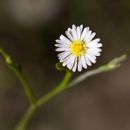pt-BR
nomes no trilho de navegação


D'Symphyotrichum parviflorum ass eng Planzenaart aus der Gattung Symphyotrichum an der Famill vun den Asteraceae.[1][2]
D'Verbreedungsgebitt vun der Aart läit an Holland, an der Belsch, zu Lëtzebuerg, a Frankräich, zu Monaco, an Éisträich, a Liechtenstein, an Ungarn, a Serbien, a Slowenien an a Polen.[3]
Se gouf vum däitsche Biolog Ch. G.D. Nees von Esenbeck fir d'éischt beschriwwen.[1]
D'Symphyotrichum parviflorum ass eng Planzenaart aus der Gattung Symphyotrichum an der Famill vun den Asteraceae.
D'Verbreedungsgebitt vun der Aart läit an Holland, an der Belsch, zu Lëtzebuerg, a Frankräich, zu Monaco, an Éisträich, a Liechtenstein, an Ungarn, a Serbien, a Slowenien an a Polen.
Se gouf vum däitsche Biolog Ch. G.D. Nees von Esenbeck fir d'éischt beschriwwen.
Symphyotrichum parviflorum (formerly Symphyotrichum subulatum var. parviflorum) is an annual and herbaceous plant commonly known as southwestern annual saltmarsh aster.[4] It is native to Mexico, the Caribbean, most of Central America, Ecuador, and the southwestern United States. It is also known by the scientific name Symphyotrichum expansum.
Southwestern annual saltmarsh aster usually flowers from July through November, but sometimes into January. It has white, sometimes pink, ray florets surrounding yellow disk florets. As the plant is drying after pollination, each ray floret curls into 1 to 2 coils.[5]
The basionym of Symphyotrichum parviflorum is Aster parviflorus, and it was first described by Christian Gottfried Daniel Nees von Esenbeck ("Nees") in 1818.[2] It also has been called Symphyotrichum expansum with the basionym Erigeron expansus[3] and Symphyotrichum subulatum var. parviflorum.[5]
Symphyotrichum parviflorum is native to Mexico, the Caribbean, most of Central America, Ecuador, and the southwestern United States. It is an introduced species in central Europe.[1] Flora of North America reports an introduction of the species in Hawaii and Japan. It grows in marshy habitats and roadsides at 0–1,100 meters (0–3,600 feet), sometimes up to 4,000 m (13,100 ft), and it is often considered weedy.[5]
As of December 2021, NatureServe gives no global status rank to this plant. It does rank it as Critically Imperiled in Nevada.[6]
Symphyotrichum parviflorum (formerly Symphyotrichum subulatum var. parviflorum) is an annual and herbaceous plant commonly known as southwestern annual saltmarsh aster. It is native to Mexico, the Caribbean, most of Central America, Ecuador, and the southwestern United States. It is also known by the scientific name Symphyotrichum expansum.